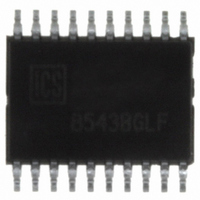ICS8543BGLF IDT, Integrated Device Technology Inc, ICS8543BGLF Datasheet - Page 14

ICS8543BGLF
Manufacturer Part Number
ICS8543BGLF
Description
IC FANOUT BUFF DIFF-LVDS 20TSSOP
Manufacturer
IDT, Integrated Device Technology Inc
Type
Fanout Buffer (Distribution), Multiplexerr
Series
HiPerClockS™r
Datasheet
1.ICS8543BGLF.pdf
(18 pages)
Specifications of ICS8543BGLF
Number Of Circuits
1
Ratio - Input:output
2:4
Differential - Input:output
Yes/Yes
Input
CML, HCSL, LVDS, LVHSTL, LVPECL, SSTL
Output
LVDS
Frequency - Max
800MHz
Voltage - Supply
3.135 V ~ 3.465 V
Operating Temperature
0°C ~ 70°C
Mounting Type
Surface Mount
Package / Case
20-TSSOP
Frequency-max
800MHz
Number Of Clock Inputs
2
Mode Of Operation
Differential
Output Frequency
800MHz
Output Logic Level
LVDS
Operating Supply Voltage (min)
3.135V
Operating Supply Voltage (typ)
3.3V
Operating Supply Voltage (max)
3.465V
Package Type
TSSOP
Operating Temp Range
0C to 70C
Operating Temperature Classification
Commercial
Mounting
Surface Mount
Pin Count
20
Lead Free Status / RoHS Status
Lead free / RoHS Compliant
Other names
800-1186
800-1186-5
800-1186
8543BGLF
800-1186-5
800-1186
8543BGLF
Available stocks
Company
Part Number
Manufacturer
Quantity
Price
Company:
Part Number:
ICS8543BGLF
Manufacturer:
IDT
Quantity:
755
Part Number:
ICS8543BGLFT
Manufacturer:
IDT
Quantity:
20 000
ICS8543 Data Sheet
Power Considerations
This section provides information on power dissipation and junction temperature for the ICS8543.
Equations and example calculations are also provided.
1.
The total power dissipation for the ICS8543 is the sum of the core power plus the power dissipated in the load(s).
The following is the power dissipation for V
2. Junction Temperature.
Junction temperature, Tj, is the temperature at the junction of the bond wire and bond pad directly affects the reliability of the device. The
maximum recommended junction temperature is 125°C. Limiting the internal transistor junction temperature, Tj, to 125°C ensures that the bond
wire and bond pad temperature remains below 125°C.
In order to calculate junction temperature, the appropriate junction-to-ambient thermal resistance θ
a multi-layer board, the appropriate value is 73.2°C/W per Table 6 below.
Therefore, Tj for an ambient temperature of 70°C with all outputs switching is:
This calculation is only an example. Tj will obviously vary depending on the number of loaded outputs, supply voltage, air flow and the type of
board (multi-layer).
Table 6. Thermal Resitance
ICS8543BG REVISION E DECEMBER 17, 2010
Linear Feet per Minute
Single-Layer PCB, JEDEC Standard Test Boards
Multi-Layer PCB, JEDEC Standard Test Boards
Power Dissipation.
•
Power (core)
The equation for Tj is as follows: Tj = θ
Tj = Junction Temperature
θ
Pd_total = Total Device Power Dissipation (example calculation is in section 1 above)
T
70°C + 0.173W * 73.2°C/W = 82.7°C. This is below the limit of 125°C.
JA
A
= Ambient Temperature
= Junction-to-Ambient Thermal Resistance
MAX
= V
DD_MAX
θ
JA
for 20 Lead TSSOP, Forced Convection
* I
DD_MAX
DD
= 3.3V + 5% = 3.465V, which gives worst case results.
JA
= 3.465V * 50mA = 173.25mW
* Pd_total + T
θ
114.5°C/W
JA
73.2°C/W
A
by Velocity
0
14
98.0°C/W
66.6°C/W
LOW SKEW, 1-to-4, DIFFERENTIAL-TO-LVDS FANOUT BUFFER
200
JA
must be used. Assuming no air flow and
©2010 Integrated Device Technology, Inc.
88.0°C/W
63.5°C/W
500














